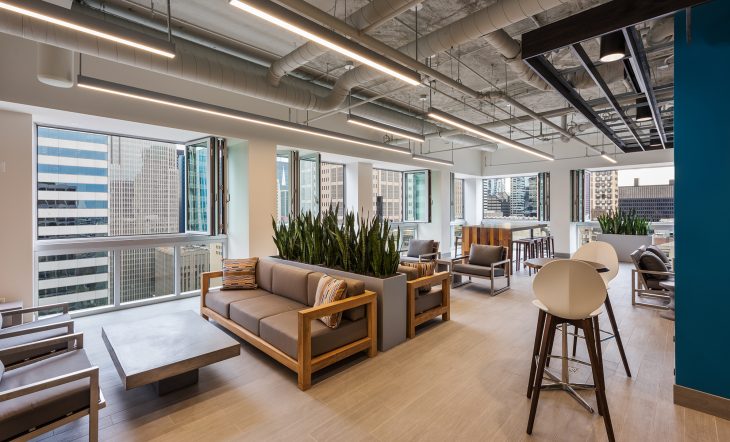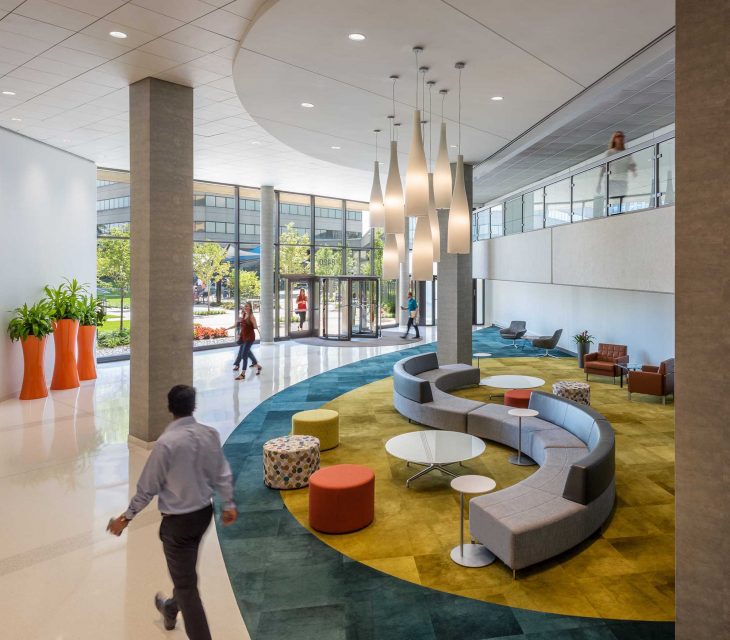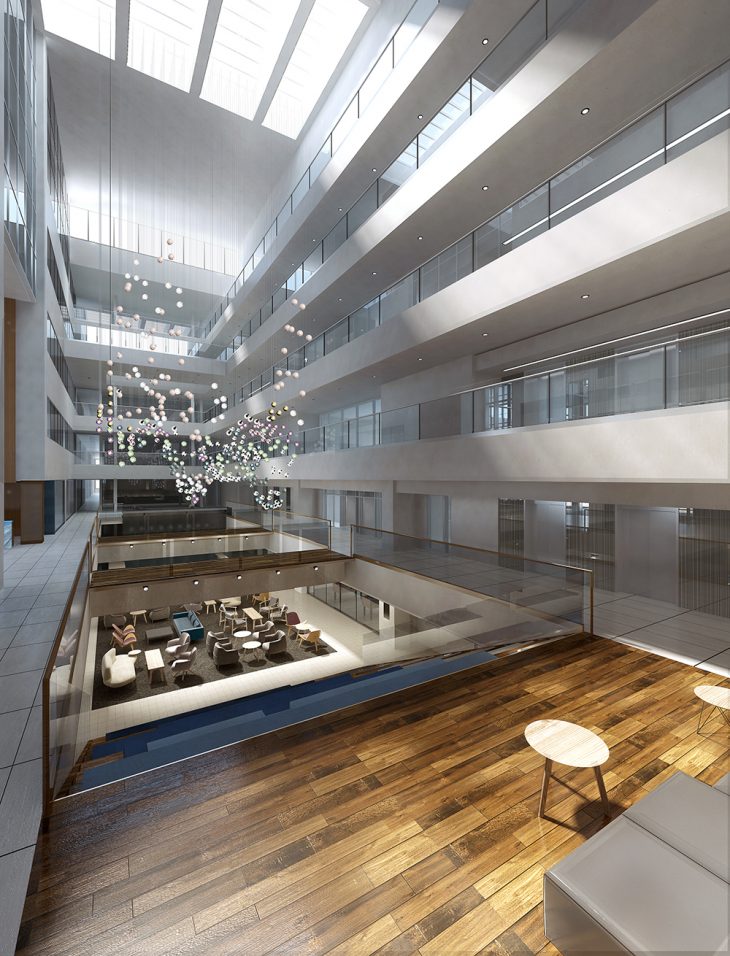How experience-centric spaces provide the platform for the modern office.
There are many factors that influence contemporary office design besides the type of business that will occupy the space, how many employees it must accommodate and the culture of the organization. Changing work habits come into play, too. A recent study showed that up to 70 percent of knowledge-worker professionals work remotely at least one day a week, and more than 50 percent do so more often than that.
For these people, and their colleagues who are there from 9 to 5, Monday through Friday, the office should be welcoming and comfortable while also driving productivity. Workplace-focused designers can take some tips from an industry for which those are fundamental: hospitality.
Look to some of the smaller boutique hotels, with their emphasis on style, personality and truly personal comfort and service. The emphasis is on the quality of the user experience. Here are seven ways that amenities characteristic of that hospitality niche can improve the work space.

A rooftop that puts you above the rest
Guests in upscale, urban hotels have come to practically expect outdoor space on the roof. Almost always with a bar, these spaces provide stylish and comfortable seating in both small, intimate cabana type enclosures and larger “rooms” that can accommodate dozens. These rooftop watering holes typically become after-work hotspots, and the same concept has been incorporated into some forward-thinking office design.
For example, the roof of the 17th floor of 1 North Dearborn in Chicago provides tenants not only with outdoor space in which to work, have lunch or simply get some fresh air, it also includes a lounge with a fireplace, games and a custom mural. This expansion of the property’s amenities increases tenant satisfaction without any reduction of leasable space, and with an unexpected and environmentally conscientious extra perk: The roof is home to a working beehive, and at the end of the year each tenant receives a jar of honey.
A room with a view
You don’t need a roof deck to give tenants air, light and a refreshing getaway. A large room with floor to ceiling windows will do, especially if the windows can be opened to enhance the view with fresh air. The room can become a lounge, workspace or both. Beyond providing space for work, coffee breaks and small group meetings, these casual environments can create the feel of a private club and cultivate a sense of community in both multi-tenant buildings and individual company spaces.

200 W. Jackson in Chicago offers The Notch on the 28th floor, a bar and recreation area that mimics a hotel’s indoor/outdoor lounge, including a reception area and working windows with a view of downtown. A couple of blocks away, the bar in 123 N. Wacker’s lounge includes a barista during the workday, and tenants can reserve the space to serve cocktails at private functions after 5:00.
Get the fitness center in shape
The benefits of a fitness center in the workplace are obvious, and it’s not just about convenience and maintaining wellness anymore. A quality fitness experience contributes to employee retention.
Healthy workers are better workers. And with ever-rising expectations around the quality of work life, those workers are happier with a fitness center that is as well designed, equipped, staffed and maintained as any upscale chain club.
High-end design, third-party fitness management and even branding pay off. Tenants of 1 N. Dearborn in Chicago have access to The Works, which evokes the feel of a private health club with state-of-the art equipment, premium locker rooms and a social lounge. Suburban office owners are also stepping up their fitness center game. Franklin Partners, owners of The Shuman in Naperville, Illinois, is contracting a third-party fitness manager, Lifestart Fitness, to manage the workout and training facilities in its new amenity space. There’s even the “Shuman Open,” a golf simulator down the hall.
Dining options that stop just short of room service
While most office building restaurants don’t have direct-to-desk delivery (yet), many food halls allow tenants to use an app for ordering and pick up, an option that saves employees valuable time and keeps their dining dollars in the building.
Vending machines are getting upgrades, too. At their 200 W. Jackson location in Chicago, Farmer’s Fridge offers building tenants a cashless grab ‘n go.
The lobby as meeting space, lounge and living room
Hotel lobbies have long been designed to function as large living rooms, with seating areas that vary in size for large groups and individual travelers alike. Increasingly, office buildings are adapting this design approach to create small meeting areas, comfortable and relaxing retreats and to even function as central gathering places.

A newly renovated lobby at US Cellular Plaza near Chicago’s O’Hare airport reflects this trend. The lounge-like lobby experience offers a bright, welcoming space for employees to gather, inspired by hospitality trends. It features sculptural light fixtures, media screens, and a guest-friendly security desk. Meanwhile, the lobby at 980 N. Michigan Avenue on Chicago’s Mag Mile will soon feature sleek new furniture and fixtures to create a hospitality-focused space where tenants and visitors can linger and enjoy.
Relax, re-center, recharge
The benefits of meditation, or simply quiet time in a relaxing place, are widely studied and becoming more commonly accepted and practiced in the workplace. Restful spaces improve employee wellness, not to mention productivity. Even if such spaces in the workplace don’t incorporate all of the elements of the hotel spa, such as massages and facials, they do provide soothing environments for employees to slow down.

A concierge to make life less stressful
The concierge in a high-end hotel has all the answers, time and resources to make the guest’s stay comfortable and convenient. That service is finding its way into office lobbies and reception areas.
The Shuman plans to offer a concierge to make the work day less stressful with services that may include dry-cleaning pickup and drop-off, restaurant reservations and more.
In addition to convenience, a concierge invites interaction that leads to familiarity with an organization’s employees and their preferences, habits and tastes.
Embracing our role as architects of welcoming spaces
Designing for our clients goes wider and deeper than the aesthetic response. Our design process includes deep thought around human interaction, community engagement and tenant satisfaction. These elements are as important to creating a functional and productive workspace as any other aspect of the design/build process.
With the ongoing evolution in the nature of work, the role it plays in people’s lives and how work is balanced with personal needs to meet changing—and ever higher—expectations, the workplace itself has evolved to become richer, more layered, and more focused on the end-user. Creating those environments requires designers to look beyond the bounds of traditional workplace design.


